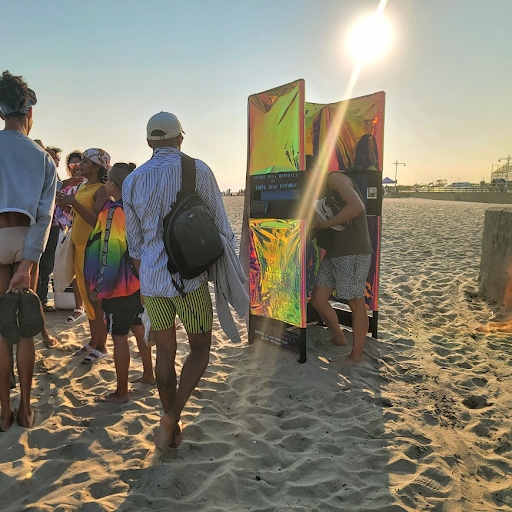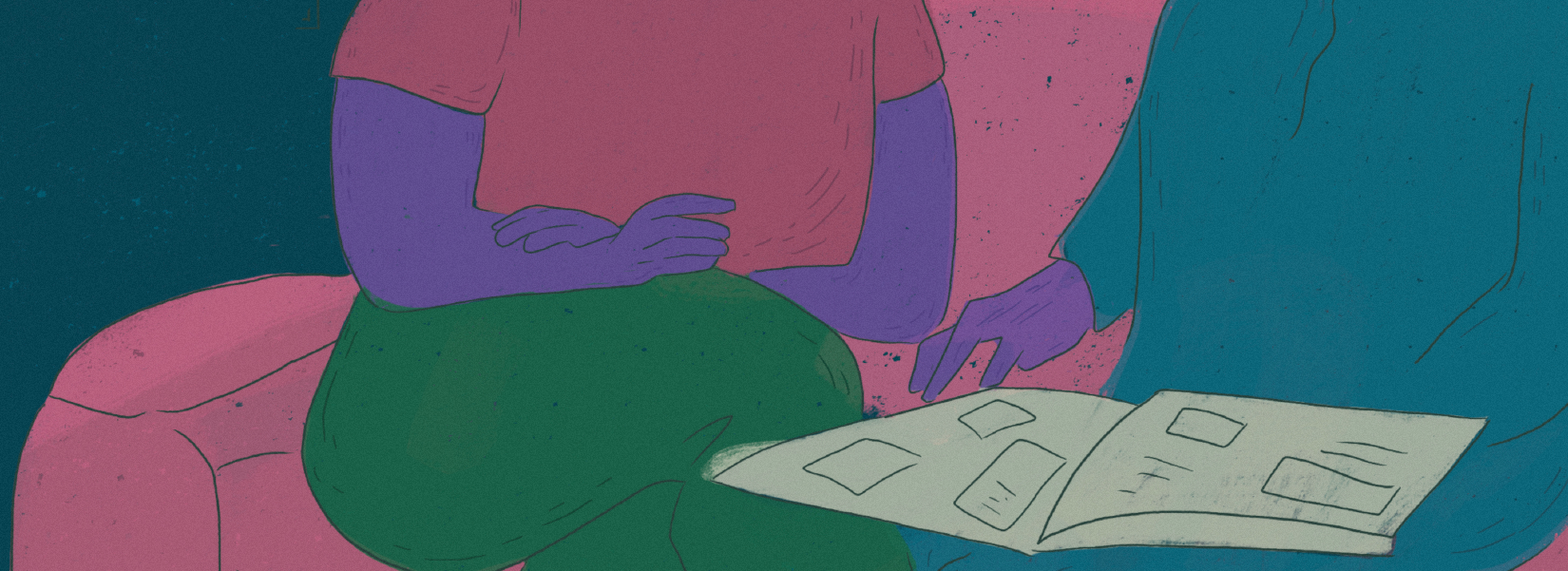The People’s Riisearch Archive is an ongoing project that aims to collect, compile, share, and mobilize materials about the queer history of People’s Beach at Jacob Riis Park in Neponsit, Queens, New York City, in the wake of significant changes to the beach’s built environment. Official decision-making and information-sharing processes have prioritized nearby homeowners and often failed to effectively include a largely nonresidential community of queer beachgoers.
Participatory archival research is often used to build collective knowledge about lived experiences of collective and institutional-scale events like a social movement, migration history, the passage of a law or policy, or life in a particular place or among people of a shared identity. Archival research generates knowledge about historical contexts in the present day, helping build knowledge about processes of change and how we got where we are today.
The People’s Riisearch Archive recognizes the role that archival materials have played in making claims to the space outside of formal ownership and seeks to compile archival materials into a digital “community archive hub.” While property records (a form of archiving that represents one particular way of relating to land) are often used to demonstrate claims to a place, community organizers and advocates have mobilized archival evidence from as early as the 1940s to make historical claims to the beach as a sacred space of queer gathering.
Participants in the project include representatives and members of a local organization, GLITS; a university-center partner, OBI; a team of “riisearchers”; and a wider community of beachgoers. Participants may locate relevant materials in existing institutional archives or publications and share the location of those materials; interview queer elders about their experiences on and memories of the beach; record their own memories in an on-site audio recording booth installation (“oral futures booth”); contribute their own photographs, event flyers, stories, and other ephemera related to the beach’s social space; and annotate, respond to, make art about, and otherwise engage with such materials through installations, workshops, and online submissions.

Types of Knowledge Archival Research Generates
Traditionally, archives have acted as evidence-based enforcers of dominant or exclusive stories of why things are the way they are today. But broadly understood, an archive can be about anything that people direct enough resources toward preserving. For example, an archive might give evidence about:
- the life of an individual (e.g., the Robert Moses Papers at the New York Public Library or the Octavia E. Butler: Telling My Stories collection at The Huntington)
- the experiences and actions of a community or the people organizing around a particular identity (e.g., the Lesbian Herstory Archives, which houses materials about lesbians and their communities, or Building a Black Archive, which focuses on Black Diasporic communities in Canada)
- an event or social movement (e.g., the #searchunderoccupy exhibit, which focused on the Occupy Wall Street movement, or social movements more generally as is the case with Interference Archive)
- a cultural practice or artform (e.g., New York Quilt Project)
As you can see, archival research might involve drawing on multiple archival sources. As such, the potential knowledge generated from archival research, in terms of subject areas, is quite vast.
Participatory archival research is adept at making connections between the present-day and historical moments or recognizing the present as future history. Participatory archival research can, then, act like a time machine, allowing participants to connect to the past by interacting with preserved materials and connect to the future by preserving contemporary materials so future community members, organizers, activists, cultural workers, historians, and other interested people may access them. As such, participatory archival research can help build intergenerational knowledge. It is particularly useful when navigating displacements or generational disruptions and when considering people, identities, histories, practices, and narratives that have been under- or misrepresented, undervalued, obscured, and otherwise denied resources.
How Archival Research Can Build Relationships and People Power
Understanding the root causes of present-day problems is an essential part of communities knowing their power. Archival research is a method for making visible the artifacts of the past that illuminate how things got to be the way they are in the present. The hiding or destruction of evidence does not need to be overt or intentional to have an impact on a community’s ability to provide evidence of their efforts and activities. But loss of evidence can be considered a violent erasure of the histories and peoples which they represent. If an institution floods, or a community center downsizes and lets go of old materials, or a family photo album is lost in a fire, the histories of these times and places cannot easily be reproduced.
When potential or existing archives are damaged, undervalued, or improperly preserved, what’s often left are oppressive surveillance and capital-driven archives such as police records, court proceedings, and property records. Participatory archival research is often responsive to this and aims to both consider the material needs of preservation of existing archives and document and preserve memories and materials as sources of evidence for future needs.
As archival research often generates collective knowledge about a community, culture, and place, it is particularly well suited for building intergenerational relationships and a sense of belonging and connection. The act of gathering, sorting through, and otherwise relating to archival materials together collectivizes this experience and provides ample ground for reflection and relationship building among participants. Living archives and other models that invite ongoing commentary from participants also use the archive as a forum for conversation among contributors over time. Archives about a community redistribute narrative authority away from top-down institutions.
Time, Capacity and Resources, and Tools Needed
Care for archival materials can be challenging. Have you ever struggled to find your own birth certificate, pay stub, or maybe even a favorite photo on your phone? Maybe you have opened an old notebook and noticed some of the ink was faded or water damaged, brought out an external hard drive only to realize you didn’t have a matching port on your computer, or lost access to a social media account. Effective archiving is supported by resources like time, physical and digital storage space with protection from the elements, tech equipment capable of reading relevant data formats, backups of files, and organizational strategies like tags, descriptions, and finding guides. Robust archiving requires institutional and collective care, as is the case with government, university, museum, corporate, organizational, community, and participatory archives, as well as initiatives directed toward supporting people in preserving, organizing, and making long-term plans for their personal archives.
The archive and the process of archiving should not be considered a finished product. At its best, archiving is open to new information about past events and acknowledges limitations that may have contributed to existing evidence.
A document with a list of questions that will help you to identify the resources needed to build an archive, open an existing archive to deeper participation, and engage in participatory research through archival materials can be found in the Related Resources section.
Pitfalls, Challenges, and Myths
Myth 1: Power over = objectivity and authority
A critical PAR approach to archival research invites curiosity about how power impacts what is preserved (and what is not) and attempts to transform myths of objectivity. Universities, libraries, and government institutions are authorities on neither truth nor value despite projections of dominance and legitimacy. Their exclusions prevent robust, textured, and collective knowledge making.
It is essential to maintain a critical eye on sources. Read between the lines for evidence of resistance to modes of surveillance and documentation that end up archived, validate people’s knowledge and sense of expertise regarding their embodied experiences, and navigate or challenge access restrictions.
Myth 2: Permanence
While archives are intended to be preserved, physical and digital materials alike are subject to damage and degradation. They might be impacted by environmental and climate injustices such as floods and fires. Changes in institutional capacity might also leave an archive vulnerable to a decrease in or loss of care. Additionally, changes in the present impact the meanings of archived materials—for instance, the destruction of a landmark might give new meaning to an image including it.
This means participatory researchers should include making long-term plans for passing something down and transferring care, storing backups of materials, building in processes for iterative description and commentary, and fighting for safer and more just conditions for all. This will ensure that people have access to the materials needed to care for themselves and sources of evidence of their living.
Myth 3: Archives are all organized with participatory researchers in mind
Organizational strategies may and often do differ from participatory research imperatives and community needs in ways that can make searching for materials for specific ends difficult. While finding guides may be helpful, consider asking librarians, archivists, and people who have researched the collection for support. Bring a notebook and, if allowed, a camera to support documentation of what you do come across in an archive so that you can share it with others and reflect later.
Weaving in Cultural Strategy
The reclaiming and rethinking of archives through research has been impactful within social justice movements and in the public more broadly, as evidenced by backlash “culture wars” over the interpretation of Black history, queer history, Asian American history, and more. Grounding in what we know today of how we interpret, navigate, create love and joy, and survive the world can provide insight into existing historical archives, as well as insight into abundant gaps that have erased and flattened historically othered people. Toni Morrison’s landmark novel Beloved, for example, derives from Morrison’s creative inquiry into a newspaper clipping. Likewise, your PAR group can build upon evidence pulled from archival research through collage, writing, fiction, and letter writing to deepen and create complexity in the interpretation, opening up new questions and lines of inquiry in the process.
Archival research can also be a source of community reconnection and advocacy, as evidenced by the work of the Texas Freedom Colonies Project. Freedom colony descendants led a process to document the hundreds of small, often off-the-grid free towns established by Black Americans in Texas after emancipation. Many of these processes involve the integration of oral history, storytelling, and other folklore practices in conversation with the presence of bits of evidence found in the archives—be they official or familial.
To bring greater relevance to researchers, your PAR team may also want to think about your work in relation to future archives and the importance of documenting your own process in the way you want to leave it for future researchers and families.
Related Resources
Participatory archival research:
- Memory Lab Network
- Build Your Archive
- “Questions for Building an Archive” contains a list of questions to help you identify the resources needed to build an archive, open an existing archive to deeper participation, and engage in participatory research through archival materials.
- “Your Personal Archiving Project: Where Do You Start?” Library of Congress Blogs
- Collections Care guides by the Library of Congress provide basic information on care, handling, and storage of collections of paper, photographs, audiovisual formats, and other materials.
- Digitization for Everybody is a course about the present state of standards and recommended best practices for creating high-quality digital still images of textual documents, photographs, graphics, and other “flat” cultural heritage resources.
- Documenting the Now develops open-source tools and community-centered practices that support the ethical collection, use, and preservation of publicly available content shared on web and social media.
- StoryCorps DIY is a set of multimedia, self-paced courses for community organizations seeking to embed storytelling into their work.
Participatory archival projects:


